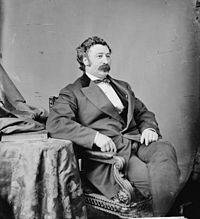James S. Negley
James Scott Negley | |
|---|---|
 James Scott Negley | |
| Born | December 26, 1826 Pittsburgh, Pennsylvania |
| Died | August 7, 1901 (aged 74) Plainfield, New Jersey |
| Place of burial | Allegheny Cemetery, Pittsburgh, Pennsylvania |
| Allegiance | United States of America Union |
| Service | United States Army Union Army |
| Years of service | 1846–1848, 1861–1865 |
| Rank | |
| Battles / wars | American Civil War |
James Scott Negley (December 26, 1826 – August 7, 1901) was an American Civil War General, farmer, railroader, and U.S. Representative from the state of Pennsylvania. He played a key role in the Union victory at the Battle of Stones River.
Early life
Negley was born in Pittsburgh, Pennsylvania, son of Jacob Negley and Mary Ann Scott. His aunt Sarah married Thomas Mellon. He was educated in public schools, and graduated from the Western University of Pennsylvania (now called the University of Pittsburgh). He served in a volunteer regiment, Company K of the Duquesne Greys, 1st Pennsylvania Volunteers, during the Mexican-American War. After the war, he became a farmer and horticulturist.
Civil War
On April 19, 1861, Negley was appointed brigadier general in the Pennsylvania Militia. He raised a brigade of Pennsylvania volunteers and served under Robert Patterson in the Shenandoah Valley in 1861. His appointment as brigadier general expired on July 20 but he was reappointed brigadier general of volunteers on October 1, 1861. In October, he was placed in command of the 7th Brigade in the Department of the Ohio. He commanded the Union expedition (raid) against Chattanooga during the Confederate Heartland Offensive. The expedition proved to be a successful demonstration of the Union Army's ability to strike deep into the heart of Confederate held territory.[1]
On November 29, 1862, he was appointed major general of volunteers and took command of the 8th Division in the Army of the Ohio. His division became the 2nd Division in George H. Thomas' Center Wing of the XIV Corps during the Battle of Stones River. On the second day of fighting, he led a successful counterattack against Maj. Gen. John C. Breckinridge on the Union left flank. He commanded his division during the Tullahoma Campaign and the Battle of Chickamauga. During the maneuvering that preceded the Battle of Chickamauga, Negley's division, in the advance of Maj. Gen. George H. Thomas's corps, was almost trapped in a cul-de-sac named McLemore's Cove, but command confusion in the Confederate Army of Tennessee allowed them to escape in what became known as the Battle of Davis' Crossroads.[2] After the Union defeat at Chickamauga, Negley, whose division became scattered during the second day's fighting, was relieved of command, but was acquitted of any wrongdoing during the battle. The most recent study of his actions is highly critical to the general for vanishing from sight without anyone knowing where to find him.[3] Negley, however, blamed his misfortunes on the prejudices toward him of West Point graduates. When Ulysses S. Grant became general-in-chief in 1864 he discussed restoring Negley to command.[4] However, after serving on several administrative boards, Negley resigned in January 1865.
Fort Negley, built in Nashville, Tennessee in 1862 was named after him. It was the largest stone inland fort built during the war.
Postbellum career
After the war, Negley was elected as a Republican to the United States Congress in 1868 and served from 1869 to 1875.
In 1877, during the Pittsburgh Railway Riots, Negley served as commander of the militia organized by the city of Pittsburgh to maintain order in the city.[5]: 113–4
He served on the board of managers of the National Home for Disabled Volunteer Soldiers from 1874 to 1878 and from 1882 to 1888. He was re-elected to Congress in 1884 and served from 1885 to 1887. After retiring from politics, he was engaged in the railroad industry.
In 1897 he became a Veteran Companion of the Pennsylvania Commandery of the Military Order of Foreign Wars.
Negley died in Plainfield, New Jersey, aged 74. He is buried in the Allegheny Cemetery in Pittsburgh.
See also
Notes
- ^ James B. Jones, Jr. "Negley's Raid." North & South, vol. 11, no. 2, p. 84.
- ^ Cozzens, pp. 175-85.
- ^ David Powell, "Negley at Horseshoe Ridge," in The Chickamauga Campaign, ed. Steven E. Woodworth, Carbondale: Southern Illinois University Press, 2010), pp. 140-164.
- ^ Grant, p. 368.
- ^ McCabe, James Dabney; Edward Winslow Martin. The History of the Great Riots: The Strikes and Riots on the Various Railroads of the United States and in the Mining Regions Together with a Full History of the Molly Maguires.
References
- Cozzens, Peter. This Terrible Sound: The Battle of Chickamauga. Urbana: University of Illinois Press, 1992. ISBN 0-252-02236-X.
- Eicher, John H., and David J. Eicher. Civil War High Commands. Stanford, CA: Stanford University Press, 2001. ISBN 0-8047-3641-3.
- Grant, Ulysses S. Personal Memoirs of U. S. Grant. 2 vols. Charles L. Webster & Company, 1885–86. ISBN 0-914427-67-9.
- Warner, Ezra J. Generals in Blue: Lives of the Union Commanders. Baton Rouge: Louisiana State University Press, 1964. ISBN 0-8071-0822-7.
- United States Congress. "James S. Negley (id: N000024)". Biographical Directory of the United States Congress. Retrieved on 2008-11-05
External links
- University of Pittsburgh alumni
- 1826 births
- 1901 deaths
- American horticulturists
- Members of the United States House of Representatives from Pennsylvania
- People of Pennsylvania in the American Civil War
- Politicians from Pittsburgh
- Union Army generals
- Pennsylvania Republicans
- Republican Party members of the United States House of Representatives
- Burials at Allegheny Cemetery
- 19th-century American politicians
